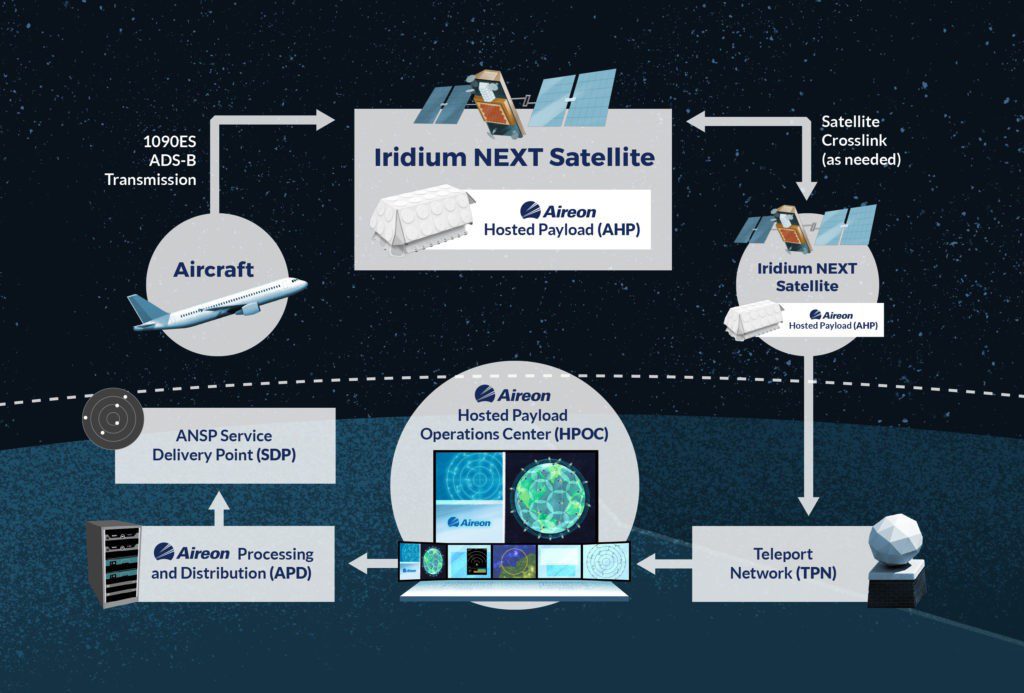For the second installment of our ‘Back-to-Basics’ blog series, 1090 Global is diving deeper into the inner workings of Aireon’s technology. At the core of the Aireon system is a technology called ADS-B which, in addition to being at the cutting-edge of aviation surveillance and aircraft tracking, is the foundation of every Aireon Hosted Payload (AHP). In the blog below, we take a deeper dive into how ADS-B works, the payload design and how the Aireon data travels from an aircraft to its final destination.
As you may have read in our first “Back-to-Basics” blog, ADS-B is a surveillance technology that broadcasts an aircraft’s identity, a precise GPS position, altitude and velocity to other entities. The signal is broadcast through antennas that send this information 2x / second (0.5 seconds bottom mount antenna, 0.5 seconds top mount antenna). It is “automatic” because no work is required from the pilot or Air Traffic Controller to broadcast the signal. It is dependent because it relies on on-board avionics such as GPS, to provide position information to other parties.
What sets Aireon’s system apart from the pack is that it uses space-based ADS-B technology to transfer data, eliminating the need for ground stations, and making it possible to provide continuous real-time aircraft surveillance coverage over oceanic and polar airspace, which does not exist today. By sending the data over the Iridium® NEXT global satellite network, Aireon will be the first-ever, global, real-time, aircraft tracking and surveillance service, and is set to revolutionize the global aviation industry.
How it Works
The Aireon system is hosted on the Iridium NEXT satellite constellation. But who is Iridium and what is Iridium NEXT?
Iridium operates the largest commercial and only truly global, communication satellite constellation today, comprised of 66 low Earth orbit (LEO) satellites that blankets the earth with reliable satellite connectivity. Iridium is in the process of refreshing its original network with 66 new satellites, in an effort called Iridium NEXT. On board every Iridium NEXT satellite is an AHP providing the Aireon system with unparalleled ADS-B surveillance coverage due to its unique network architecture.
How is it unique?
Each Iridium NEXT satellite is able to communicate with its neighboring satellites through a feature called “crosslinks.” Since the network resides in space, ground stations aren’t needed to enable Aireon’s technology. This factor, coupled with this unique network design, gives the Aireon system the ability to provide air traffic surveillance to areas of the world currently un-surveilled, including over oceanic and polar regions.
Getting the data from “Point A” to “Point B”
In order to use the Aireon system, aircraft need to be equipped with 1090 MHz ADS-B transponders built to any version of the DO-260, DO-260A or DO-260B (Link Versions 0, 1 and 2, respectively) standard. These are the technical terms and not something a non-industry person would likely know. The antenna should ideally be a top mounted antenna, which is commonly found on most aircraft and private jets, to ensure reliable satellite reception.
Since ADS-B is automatic, compliant aircraft will automatically send ADS-B position data (aka: messages), which will be received by the AHPs in space. Once received, the AHP will send the data, via satellite-to-satellite communication, and then down to the Aireon Teleport Network (TPN). From there, the message is sent to the Aireon Hosted Payload Operations Center (HPOC – see our first blog in this series for more info!) where it is then transferred to APD. Once finished at APD, the message is delivered to its final destination, known as an SDP or Service Delivery Point, which is usually an ANSP that has subscribed to the Aireon service. Can you believe this whole transfer is done in less than 2 seconds!?
How does the payload work?
As mentioned earlier, each AHP is designed to receive ADS-B messages from aircraft over the 1090 MHz frequency. In addition to receiving data, each payload supports multiple “beams” (picture wide circles of light like an LED flashlight) that create a robust Aireon footprint across the earth’s surface. These footprints are determined by looking at the combined coverage created by multiple beams coming from the same satellite, with a slant range of approximately 3,200 km. The larger the slant range, the larger the footprint of overlapping coverage. So far, after analyzing the footprints of the Aireon payloads currently in operation today, the Aireon system has triple satellite coverage over most of the world. Once fully operational, there will be 66 operational payloads in space, supporting multiple beams per satellite, creating a highly robust aircraft surveillance system.
A Simple Snapshot of the Aireon System’s Process in Action

Source: Aireon Technical Overview
For those interested in the abridged version of the above:
- An aircraft automatically sends its position data in the form of an ADS-B message, to an AHP located in space, hosted on an Iridium NEXT satellite.
- The AHP transfers the data over the Iridium satellite network back to earth, where it travels to the Aireon Teleport Network (TPN), where it’s then transferred to the Aireon Hosted Payload Operations Center (HPOC). From the HPOC, the ADS-B message makes it way to Aireon Data Processing (APD).
- From there, the data is sent to the Aireon customer, which is an Air Navigation Service Provider (ANSP) (aka: The Service Delivery Point (SDP).
- This entire process takes less than 2 seconds.
We hope you have found this entry informative! Stay tuned for the third edition of the “Back-to-Basics” series, focused on Aireon’s dynamic ADS-B data.